
When Swiss Skydiver outdueled Kentucky Derby (G1) winner Authentic in an epic Preakness Stakes (G1), she was recognized as the sixth filly to defeat males in the classic.
Those numbers hinge, however, upon how you define the Preakness: the first two fillies on the official list won a different kind of contest, at a different venue, that wore the Preakness label.
Preakness at Pimlico vs Gravesend
Originally staged at Pimlico from 1873-1889, the Preakness was not restored to Baltimore until 1909. During those “lost” years, a contest held in New York – at Morris Park in 1890, and then after an 1891-93 hiatus, at Gravesend from 1894-1908 – was billed as the Preakness.
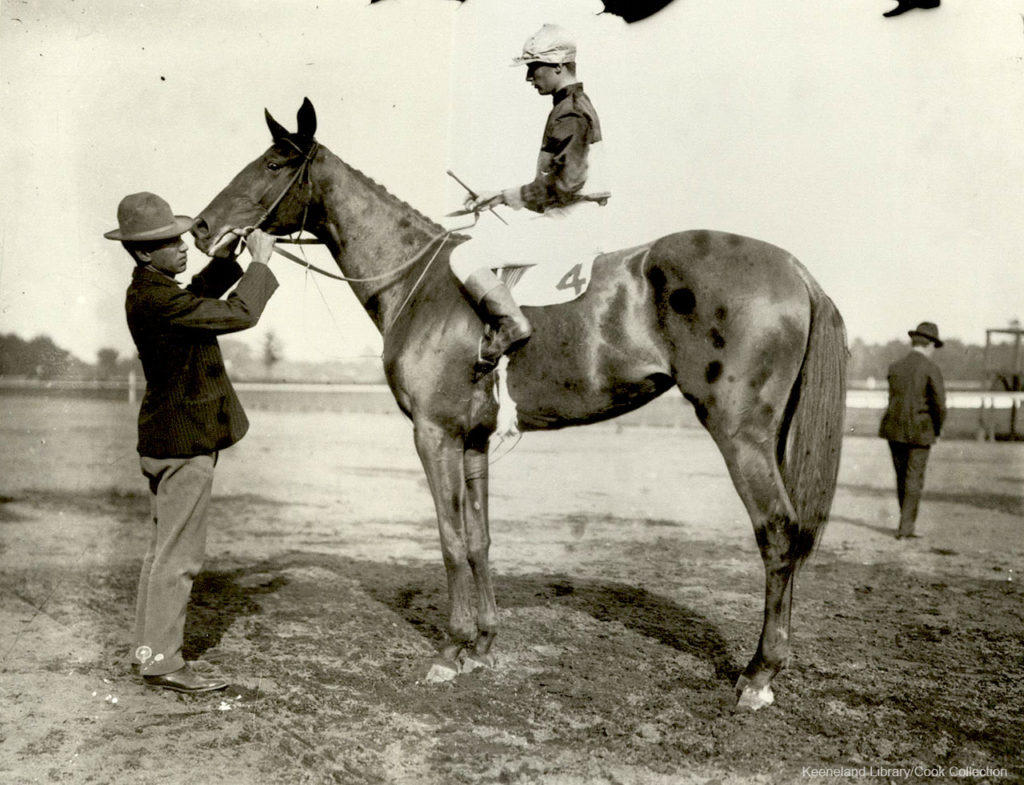
(Keeneland Library – Cook Collection)
The fillies Flocarline (1903) and Whimsical (1906) came along in that span of the Preakness in exile, as it were. Not only was the distance shorter at Gravesend – a mile and 70 yards in the years of Flocarline and Whimsical – but the race carried restrictions. According to the old charts in the Preakness media guide, the 1903 race was limited to sophomores who had “not won a race of the value of $3,000 up to the date of closing entries,” and the 1906 race carried the same restriction up to $5,000.
Perhaps that can be overlooked as another kind of ebb-and-flow of a Triple Crown race in formation? After all, you might say, the Derby distance was 1 1/2 miles until 1896; the Belmont Stakes (G1) has had a few homes as well as distance tweaks; and all three classics took time to reach the standardized 126-pound assignment for males.
But the “extramural” Preaknesses weren’t always counted as such. Indeed, only in the mid-20th century were those runnings grandfathered in as renewals of the Preakness and added to the Pimlico honor roll.
Thus if you go by the original reckoning, Rhine Maiden (1915) is the first filly to win the Preakness in a recognizable form. And her successor, Nellie Morse (1924), was described as the second female winner at the time.
What then can we make of the ex post facto decision to include Flocarline and Whimsical? Do they belong in this category? A deep dive into the physical archives would be required to give a full assessment, but some clues are readily accessible.
Flocarline – 1903 Preakness
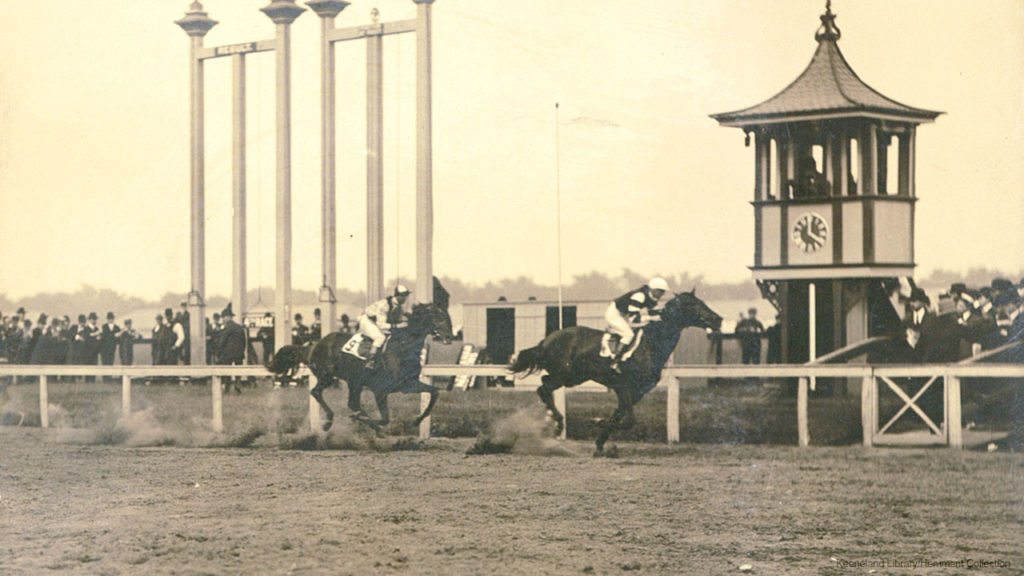
(Keeneland Library – Hemment Collection)
| Flocarline Pedigree | St. Blaise | |
| St. Florian (1889) | ||
| Feu Follet | ||
| Flocarline (1900) | ||
| King Ban | ||
| Carline (1885) | ||
| Lady Caroline |
As a juvenile, Flocarline beat males in the Chicago Ridge H. and New Orleans’ Preliminary Derby H. But her resume wasn’t overwhelming in the Preakness, where she was the 8-1 fifth choice in a six-horse field. Her foes included 8-5 favorite Mackey Dwyer, eventual winner of the American Grand National Steeplechase, and multiple stakes scorer Rightful, who’d beaten future Kentucky Derby hero Judge Himes (not a unique achievement).
Flocarline had her head in front early, eased a length back according to the chart, and came again to prevail by a half-length from Mackey Dwyer. The New York Tribune recap believed she led throughout, noting the time of 1:44 4/5 “beats the record for the distance by a second.” The chart caller credited Flocarline’s jockey, William Gannon, with an astute ride:
“Winner cleverly handled, was given a strong finish. Dwyer had no excuses, was under punishment in home stretch. Others outclassed.”
Yet it’s worth noting that her Preakness didn’t stand out when Daily Racing Form had cause to mention Flocarline in a Sept. 14, 1910, column on American-bred entries for the 1912 English classics. Then a successful broodmare whose son Kempion was given classic entries, Flocarline was summed up as a “fast mare…which raced well over Chicago tracks in her days of activity on the track.”
Flocarline did have another useful piece of form at Gravesend though, placing second in the 1903 Broadway to the high-class Irish Lad.
Whimsical – 1906 Preakness
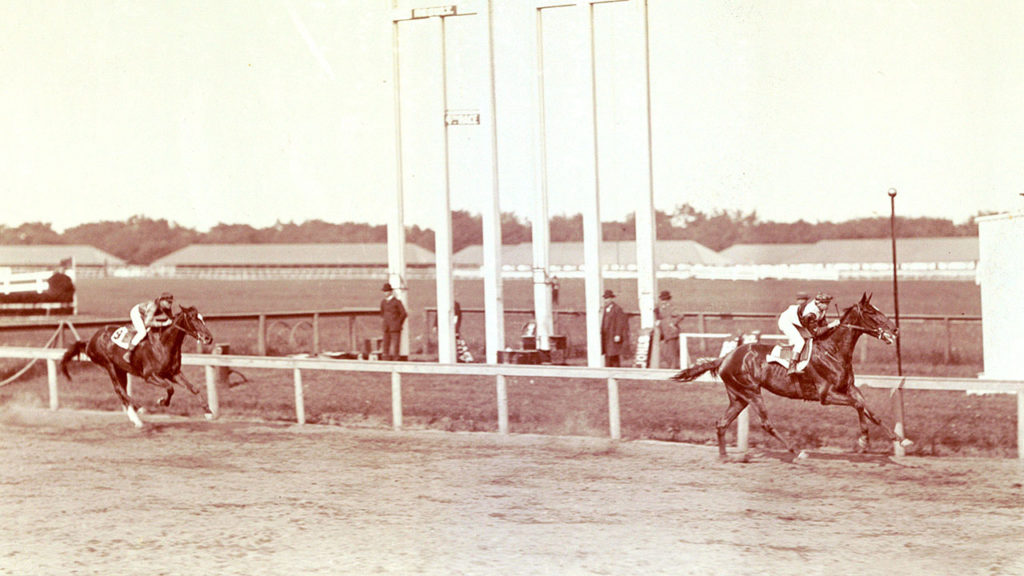
(Keeneland Library – Hemment Collection)
| Whimsical Pedigree | Orme (GB) | |
| Orlando (GB) (1899) | ||
| Huelva (GB) | ||
| Whimsical (1903) | ||
| Hindoo | ||
| Kismet (1892) | ||
| Roselle (GB) |
Whimsical had solid New York juvenile form in 1905. A two-time stakes winner with several placings, she was runner-up in the Champagne and the Great Eastern H. (to the best colt of his generation, Burgomaster, in the latter).
The top draw in the 1906 Preakness, Whimsical justified 8-5 favoritism by four front-running lengths, “pulling up” according to the chart. The New York Tribune commented on the one-sided affair:
“There was nothing in the race that could make her fully extend herself, and she romped home the easiest kind of a winner.”
Another filly, 40-1 Content, was easily best of the rest. To underscore the female dominance that year, Flip Flap was the 2-1 second choice if not performing up to billing.
Although Whimsical captured just one other stakes that season, it was the Standard back at Gravesend over males. She defeated Cairngorm (the 1905 Preakness winner) and Ormondale, in what was then stakes-record time for the 1 1/4-mile feature.
Like Flocarline, Whimsical was capable on her day, if not of championship timbre.
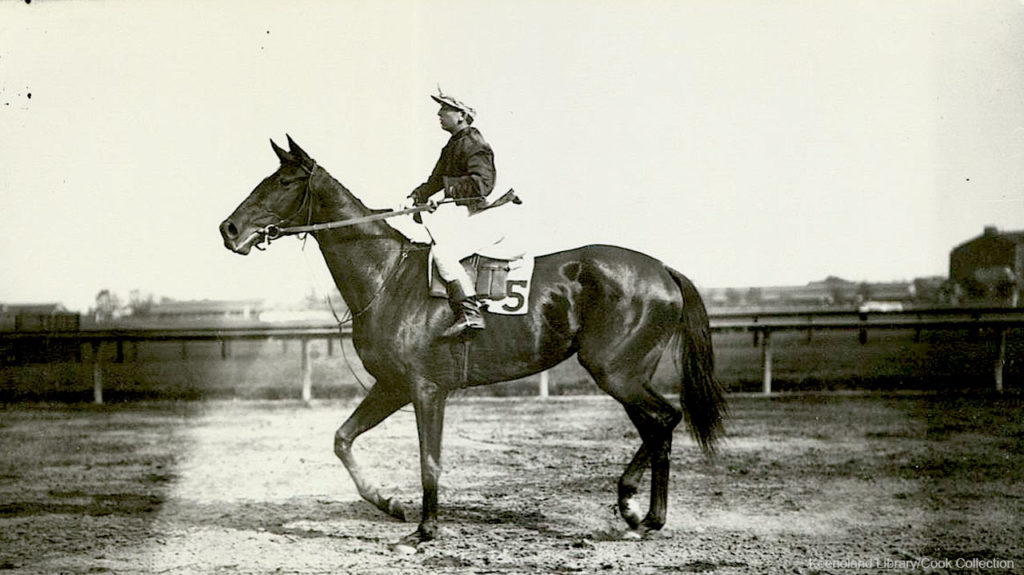
(Keeneland Library – Cook Collection)
Rhine Maiden – 1915 Preakness
| Rhine Maiden Pedigree | Springfield (GB) | |
| Watercress (1889) | ||
| Wharfedale (GB) | ||
| Rhine Maiden (1912) | ||
| Golden Garter | ||
| Gold (1904) | ||
| Miss Maxim |
After the restoration of the Preakness to Pimlico, Rhine Maiden capitalized as the controlling speed in the mud in 1915. Her first known stakes score didn’t make her the leading 3-year-old filly, for nine days earlier, the great Regret reigned as the first female Kentucky Derby winner. Only one Derby runner tried the Preakness, Norse King, who had been 15th behind Regret at Churchill Downs.
The 6-1 Rhine Maiden “went to the front in the first sixteenth and, setting a fast pace, easily held the race safe all the way.” The pace slowed markedly following the half in :48 3/5, but Rhine Maiden was still 1 1/2 lengths clear in a final time of 1:58 – for 1 1/8 miles. Runner-up Half Rock went on to finish second to the year’s top colt, The Finn, in the Belmont (albeit with only three starters).
Aside from the mud buoying her, Rhine Maiden was also benefiting from the Preakness’ handicap conditions at that time. She toted a mere 104 pounds, compared to the 116-pound highweights Runes (third) and Norse King. But she was giving four pounds to the lightweight Half Rock.
While Rhine Maiden added no other highlights to her sophomore campaign, she did take three stakes as an older distaffer. Her 1916 Clarendon H. came at the expense of Holiday (the 1914 Preakness winner), and the Ladies’ H. was her signature victory of 1917.
Hence Rhine Maiden comes across as a transitional figure. She resembles the Gravesend heroines in that they beat no males of lasting import in the Preakness, in race conditions that no longer apply, and none was regarded as a champion. Yet Rhine Maiden points to the future by winning at the Preakness’ true home, Pimlico, and at a distance much nearer to its now-customary 1 3/16 miles.
Nellie Morse – 1924 Preakness
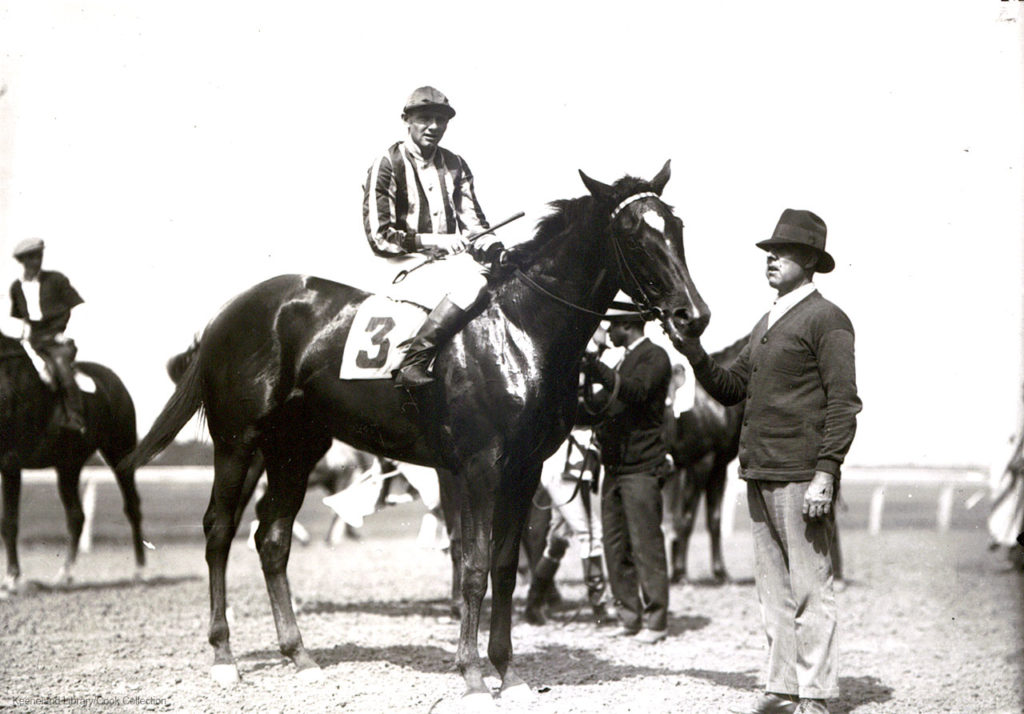
With Nellie Morse in 1924, we inch closer to our modern idea of a Preakness queen: a champion defeating several smart males at scale weights. The increase in Preakness quality corresponds with a massive hike in post-World War I purses: Flocarline took home $1,875, Whimsical $2,145, and Rhine Maiden $1,275, but Nellie Morse banked $54,000.
Nellie Morse was an ambiguous champion, however, having to share that retrospective 3-year-old filly title with the prolific money-spinner Princess Doreen. Among the prominent juveniles of 1923, Nellie Morse captured the Fashion but placed more often in such events as the Matron and Spinaway. She reached her peak for one glittering week in Baltimore.
Landing the Pimlico Oaks, Nellie Morse wheeled right back for the 1 1/8-mile Preakness. The 12-1 shot was well placed early to chase the lone speed on a sloppy track, “then moved up rapidly on the last turn and, easily passing Sun Flag, raced into a good lead, but had to be ridden out through the last eighth.”
Nellie Morse clocked 1:57 1/5 while maintaining a 1 1/2-length margin over Transmute. The form didn’t hold up too well five days later in the Kentucky Derby, when a few Preakness runners wound up unplaced behind the legendary Black Gold.
In the long run, several 1924 Preakness alumni did turn out well. Third-placer Mad Play won the Belmont, among other big prizes over his career, and placed third to Sarazen and *Epinard in an International Special. To mention only the two most significant also-rans, Sun Flag would garner the Travers and two Pimlico Serials, and Sting would turn the Metropolitan/Suburban double in 1925.
Unfortunately, Nellie Morse did not progress with them. Finishing a hampered third (promoted to second) in the Kentucky Oaks, when attempting to concede Princess Doreen five pounds, she did not win again.
Nellie Morse didn’t disappear. Instead, she produced champion 2-year-old filly Nellie Flag, who tried two classics in 1935. A troubled fourth as the tepid favorite in the Kentucky Derby, she could not emulate her dam when seventh in the Preakness behind Triple Crown winner Omaha. But Nellie Flag has excelled herself as a broodmare whose descendants continue to prosper down the years and around the globe, from Hall of Famer Forego and dual classic champion Bold Forbes to Lakeway and, more recently, Aidan O’Brien’s Together.
Preakness fillies in the modern era
Although there was an 85-year gap between Nellie Morse and Rachel Alexandra’s Preakness conquest in 2009, not that many fillies had taken on the challenge. None attempted it after 1939, until 1980, when Kentucky Derby star Genuine Risk finished second. Then 1988 Derby vixen, Winning Colors, placed third in her Preakness. Excellent Meeting had a rough go of both jewels in 1999.
Rachel Alexandra didn’t compete in the Derby, but her 20 1/4-length tour de force in the Kentucky Oaks left little doubt that she would have stacked up versus the boys. She proved the point at Pimlico by becoming the first filly to topple a Kentucky Derby winner (Mine That Bird) in the Preakness. Rachel Alexandra gilded her Horse of the Year/Hall of Fame campaign by dismissing the champion 3-year-old male, Summer Bird, in the Haskell Invitational (G1), and repelling older males to raise the rafters in the Woodward (G1).
Swiss Skydiver came into the pandemic-delayed Preakness differently from “Rachel,” off a loss in the Oaks, but that made no difference as she returned to her best. And she edged a better Derby winner in Authentic, who ran another stellar race and still lost.
A return to the original view
As this historical tour suggests, the Preakness-winning fillies of the new millennium have far outstripped their early 20th-century precursors. Rachel Alexandra and Swiss Skydiver are a league apart from Nellie Morse, who in turn has a more persuasive profile than Rhine Maiden, Whimsical, or Flocarline.
To make that arc of development clearer, my personal inclination would be to leave the Gravesend winners out of the Preakness tabulations, as a bit too much of a stretch. Bidding adieu to Flocarline and Whimsical leaves us with four female winners, a more exclusive club.
That’s also more in line with the contemporaneous view of racing scribes of a century ago, which saw its Gravesend incarnation as a novelty, a rupture from its Pimlico origins.
A Daily Racing Form blurb from June 3, 1908 – recapping what turned out to be the final running at Gravesend – was explicit about the race’s identification with the Brooklyn track: “The Preakness Stakes was first run in 1894.”
Sources consulted:
Preakness Media Guide courtesy of the Maryland Jockey Club
https://www.pimlico.com/sites/www.pimlico.com/files/PMG.web__0.pdf
Kentucky Derby Media Guide courtesy of Churchill Downs
https://www.kentuckyderby.com/media/reference
Richard Sowers, The Kentucky Derby, Preakness and Belmont Stakes: A Comprehensive History
Avalyn Hunter, American Classic Pedigrees (1914-2002), and her affiliated website, americanclassicpedigrees.com
The Blood Horse: A Quarter-Century of American Racing and Breeding, 1916-1940, Silver Anniversary Edition
Pedigreequery.com
Daily Racing Form digital archives, drf.uky.edu
New York Tribune via Newspapers.com (hat tip to Vance Hanson)
William H.P. Robertson and Dan Farley, compilers, Hoofprints of the Century (excerpts from the Thoroughbred Record and predecessor publications)


